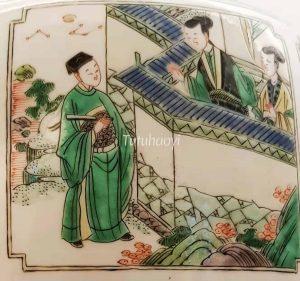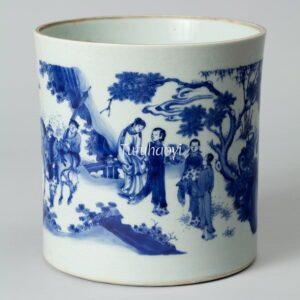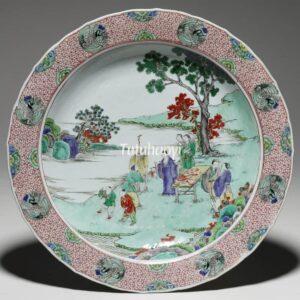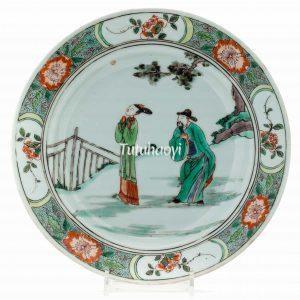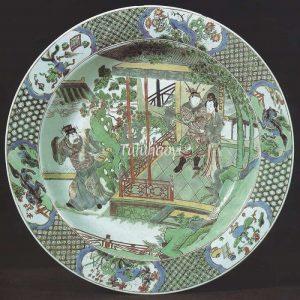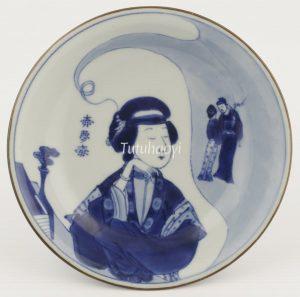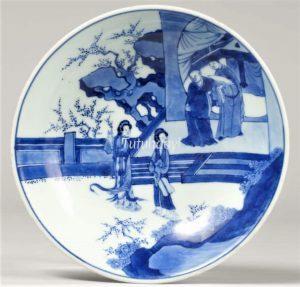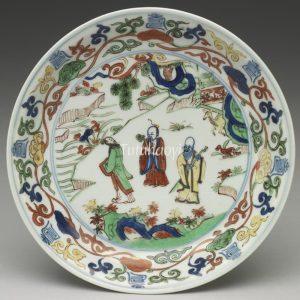Figures & Stories
Depiction of Chinese historical figures, legends, and scenes in literature
Alternatively, browse terms in alphabetical order according to their Chinese Pinyin 汉语拼音
- Chinese Pinyin:Chang He Dong Qiang (Qiang Jiao Lian Yin)
- Chinese:唱和东墙 (墙角联吟)
- Name of Image:Scholar Zhang and Cui Yingying exchanging verses in the garden
- Description:
This is from Scene Three of Act One of the Chinese classic popular drama Romance of the Western Chamber (西厢记 Xixiang Ji), written by the Yuan playwright Wang Shifu (1250–1336).
Zhang Junrui (张君瑞, also called Scholar Zhang 张生) was immediately struck by lovesickness after seeing Miss Cui Yingying at the first sight. He decided to rent a room at the Monastery of Universal Salvation 普救寺 in order to wait for an opportunity to get close to his goddess. Scholar Zhang inquired from a monk that Yingying would go to the garden to burn incense every night, so he hid behind the rockery in the garden and waited.
When Yingying came out of the corner door, Scholar Zhang saw that her fair face under the moon was even more beautiful than when he first saw her. He couldn’t help feeling love in his heart, so he composed a poem and read loudly:
The moonlight melts into the night,
Silent in the Spring, flowers in the shade.
Under the moon so bright,
Where is the beautiful maid?
(月色溶溶夜,花阴寂寂春;如何临皓魄,不见月中人。)
Yingying heard it and was touched by this refreshing poem. She composed another one to rhyme with his:
The orchid boudoir has been long lonely,
spending youth in vain.
I reckon that the poem chanter
should pity the sighing maid.
(兰闺久寂寞,无事度芳春;料得行吟者,应怜长叹人。)
Scholar Zhang and Yingying deepened their understanding through exchanging verses that night, and developed a sense of sympathy for each other, which laid their emotional foundation for having similar interests.
story scene description by Rachel Ma
Other episodes in the Romance of the Western Chamber:
Scholar Zhang embarking on his journey to sit for civil-service examinations 张生赶考
Scholar Zhang renting a room in the monastery 僧房假寓 (禅关假馆)
Repudiation of the Billet-Doux 张生跳墙 (乘夜踰垣)
Consummation of love from Western Chamber 月下佳期
Scholar Zhang getting drunk due to Madame Cui’s broken promise 张生醉酒 (崔母悔婚)
- Chinese Pinyin:Chang Ting Song Bie (Ku Yan)
- Chinese:长亭送别 (哭宴)
- Name of Image:Farewell feast at the pavilion
- Description:
This is Scene three of Act Four of The Romance of the Western Chamber (Xixiang Ji 西厢记), a famous Chinese drama written by playwright Wang Shifu 王实甫 (1250–1336) in Yuan dynasty.
Zhang Gong 张珙 (styled Junrui 君瑞, also known as Scholar Zhang), and Madame Cui’s daughter, Cui Yingying 崔莺莺, were deeply in love with each other. (Refer to Consummation of Love.) However, Madame Cui insisted that Scholar Zhang travel to the capital to sit the imperial examination, declaring that only upon achieving official recognition could he return to marry her daughter. Thus, a group of people accompanied Scholar Zhang to a pavilion in the countryside to bid him farewell as he embarked on his journey to the capital.
Zhang Sheng’s horse moved slowly, while Yingying’s carriage hurriedly followed behind. Yingying lamented, saying,
Beneath the azure, cloudy sky,
Golden blooms spread far and wide.
The west wind blows, geese southward stray,
From the north, they wing away.
Who dyes the frosted woods at dawn,
With drunken hues so brightly drawn?
It’s the tears of those who part,
Falling from a longing heart.
(碧云天, 黄花地, 西风紧, 北雁南飞
晓来谁染霜林醉? 总是离人泪)
Madame Cui ordered Hongniang 红娘 to fetch wine, instructing Yingying to offer the cup to Scholar Zhang. After drinking, Scholar Zhang sighed, ‘I have experienced the bitterness of longing these past days, but now I realise that the sorrow of parting is tenfold greater.’
Yingying urged Scholar Zhang to take care of himself. In return, Scholar Zhang vowed his unwavering devotion, declaring, ‘Who in this world could compare to you, my lady? Beyond you, Zhang Gong could never love another.’
At last, the moment of parting arrived. Scholar Zhang and Yingying exchanged tender farewells before setting off on their separate paths, their hearts heavy with longing and hope.
Story scene description by Rachel Ma
See all episodes in the Romance of the Western Chamber
Other figural stories on Chinese artworks:
The dream by the Qiantang River 钱塘梦
- Chinese Pinyin:Chen Ping Fen Rou
- Chinese:陈平分肉
- Name of Image:Chen Ping Dividing Meat
- Description:
Young Chen Ping (陈平, ?–178 BCE), later a minister of Western Han dynasty, as being an exemplar of fairness in his everyday work. According to Sima Qian’s (司马迁, 145BCE – ?) famous work Historical Records – Prime Minister Chen’s Family (史记 – 陈丞相世家 ), one day, Chen Ping’s village held a ceremony to offer sacrifice to the Earth God. He was entrusted as the arbitrator to divide the meat offerings among attending villagers after the ceremony. As he divided the meat offerings in very even quantities, a village elder remarked that Chen was very impartial, to which he replied ‘Should I one day take rule of the land, I would rule it as impartially as I split the meat offerings.’
The story scene depicted in the centre of the Kangxi plate in the collection of the British Museum was first unveiled by Dr Yibin Ni. His article with historical pictorial and literary evidence is published here.
- Chinese Pinyin:Diao Chan Jiang Xiang
- Chinese:貂蝉降香
- Name of Image:Diao Chan Praying in front of Burning Incense
- Description:
This is a scene from a popular traditional play ‘A Set of Interlocking Stratagems (连环计)’.
The war lord Dong Zhuo (董卓, ? – 192 CE) became a senior minister in the Han court. His tendency to dominate the young sovereign, Emperor Xian of Han (汉献帝, 181–234 CE), gave other ministers cause for concern. They asked Wang Yun (王允), a high-ranking official, to devise a stratagem to get rid of Dong Zhuo in the interests of the state. Wang Yun was burdened with the task, with no appetite to eat and no desire to sleep. One evening, when Wang Yun was cudgeling his brains for a perfect plan on his way to the back garden, he suddenly saw his adopted daughter, Diao Chan (貂蝉), burning joss sticks (焚香) to pray for her lost fiancé Lv Bu (吕布, also Lü Bu), who had been separated from her during the war and had become one of Dong Zhuo’s right-hand men. Wang Yun’s face lit up and came up with a perfect plan. The following plot is represented on a series of late Ming to Qing dynasty porcelain wares.
He first invited Lv Bu to his house and reunited him with Diao Chan. On the next day, Wang Yun invited Dong Zhuo for a dinner at home with Diao Chan serving the food, knowing that Dong would drool over her and fall into his trap. Sure enough, Dong Zhuo immediately fell for Diao Chan and took her home on the spot. Then Wang Yun told Lv Bu that Dong Zhuo had married Diao Chan by force. Being Dong Zhuo’s subordinate, Lv Bu had to repress his jealousy and anger. Lv Bu had been tormented emotionally for days before he finally managed to meet with Diao Chan in the back garden of Dong’s residence. Dong Zhuo discovered Lv Bu’s absence and grew suspicious. He rushed back and saw the couple together. A wedge thus was lodged between Dong Zhuo and his first lieutenant Lv Bu, which eventually caused Dong’s downfall.
References:
- Ni, Yibin (倪亦斌)《王允貂蝉合谋连环计,董卓吕布翻脸成仇敌》, Reader’s Taste《读者欣赏》 (October 2017): 114-119
- Jeffrey P. Stamen and Cynthia Volk with Yibin Ni (2017), A Culture Revealed: Kangxi-Era Chinese Porcelain from the Jie Rui Tang Collection 文采卓然:潔蕊堂藏康熙盛世瓷, Jieruitang Publishing, p. 28
- Chinese Pinyin:Dong Zhuo Da Nao Feng Yi Ting
- Chinese:董卓大闹凤仪亭
- Name of Image:The Couple’s Tryst in the Phoenix Pavilion Making Dong Zhuo Fly into a Fury
- Description:
Dong Zhuo (董卓 d. 192), a tyrannic warlord rising to power at the end of the Han dynasty, caused great concern among courtiers and officials. Wang Yun (王允), the Minister Over the Masses (司徒 Situ), was entrusted to figure out a plan to bring him down. Dong Zhuo was particularly powerful because he managed to ally with the invincible young general Lv Bu (吕布 Lü Bu), who he had adopted as his son. Wang Yun thought if he could open a rift between the two, then it would be the end of Dong.
Wang Yun first invited Lv Bu to his house to reunite him with his long-lost sweetheart Diaochan (貂蝉), who was then in Wang’s custody. The couple rekindled the passion immediately and could not wait to be together again. Then, Wang Yun treated Dong for dinner at home during which the lecherous lord was drooling over Diaochan, duly falling into Wang’s trap. Leaping at the chance, Wang Yun offered to marry Diaochan to Dong and Dong readily accepted.
When Lv Bu learned that Dong now had Diaochan in his back chambers, he was furious but had to repress his anger. One day, Lv Bu seized an opportunity to have a rendezvous with Diaochan in the back garden of Dong’s residence when Dong was in audience with the emperor. Realising Lv Bu’s absence from his side, Dong hurried back. Seeing the young couple together in the Phoenix Pavilion, Dong flipped his wig and charged at Lv Bu with Lv’s halberd. The seed of dissension was planted between the two. Without his right-hand man’s support, Dong’s power was weakened, which eventually resulted in his downfall.
One of the earliest sources of this story scene is found in a Yuan-dynasty (1271–1368) play entitled The Stratagem of Interlocking Rings (连环计 Lian Huan Ji) involving the intriguing plot of ménage à trois. The play by an anonymous author predates Romance of the Three Kingdoms (三国演义), one of the four great novels of Chinese classical literature, whose earliest preface dated 1494. Chapter Eight of the novel has full-fledged account of this story.
Reference:
Ni, Yibin (倪亦斌)《王允貂蝉合谋连环计,董卓吕布翻脸成仇敌》, Reader’s Taste《读者欣赏》 (October 2017): 114-119
- Chinese Pinyin:Du Liniang You Yuan Jing Meng
- Chinese:杜丽娘游园惊梦
- Name of Image:A Startled Romantic Dream in the Back Garden
- Description:
‘True love conquers all’ is the theme of the Peony Pavilion (牡丹亭 Mudan Ting), a musical play of fifty-five scenes written by Tang Xianzu (汤显祖, 1550–1616) in Ming dynasty. Also known as The Romance of Return of Soul (还魂记 Huanhun Ji), the play contains a supernatural love story between Du Liniang (杜丽娘), the only daughter of the Nan’an prefect (南安太守) Mr. Du, and Liu Mengmei (柳梦梅), a civil-service examination candidate. At the beginning of the play, there was a passionate rendezvous of the two in the form of Liniang’s dream in the back garden with vigorously budding bushes during a warm spring afternoon. The encounter was so indelible to the adolescent girl that she eventually died of longing for her ‘dream’ lover. The play narrates how the couple overcome all the obstacles along the way to their union. Their experiences transcend not only time and space but also life and death.
The story scene depicted in the centre of the Shunzhi bowl in the Sir Michael Butler collection and the Kangxi dish in the collection of the V&A Museum was first unveiled by Dr Yibin Ni. His research article with pictorial and literary evidence is available for view here.
References:
- 倪亦斌:《明末时尚女子的情色告白》,《艺术世界》, 上海: 上海文艺出版社, 2004-03, pp.72–73.
- 倪亦斌:《明末时尚女子的情色告白》,《看图说瓷》, 北京: 中华书局, 2008, pp.1–10.
- Chinese Pinyin:Fo Dian Qi Feng (Jing Yan)
- Chinese:佛殿奇逢 (惊艳)
- Name of Image:Scholar Zhang and Cui Yingying’s encounter in the Salvation Monastery
- Description:
This scene is from one of the most famous Chinese dramatic works, Romance of the Western Chamber 西厢记, which was written by the Yuan playwright Wang Shifu (王实甫 1260–1336). The play tells the story of a secret love affair between Zhang Gong (张珙, also called Scholar Zhang 张生) and Cui Yingying 崔莺莺, the daughter of former Prime Minister Cui of the Tang court. The lovers are aided by a clever maid, Hong Niang 红娘, who helps them overcome daunting obstacles such as an imperious mother, a prior betrothal, and an attempted abduction by a cruel bandit.
This scene is from Scene One in Act One, which describes the first encounter of the lovers in a temple. Zhang is going to the capital to attend the highest civil service examinations. On the way he pays a visit to the nearby Salvation Monastery. In the monastery, a monk named Fa Cong 法聪 shows him around. Zhang meets Cui and her maid in front of the Buddha hall. Startled by Cui’s beauty, Zhang can’t keep his eyes off her. However, seeing a male stranger nearby, Hong Niang advises her lady Yingying to leave immediately.
image identification and story scene description by Dr Yibin Ni
More discussion on Scholar Zhang’s gaze at Yingying is available in this blog here.
Other episodes in the Romance of the Western Chamber:
Scholar Zhang embarking on his journey to sit for civil-service examinations 张生赶考
Scholar Zhang and Cui Yingying exchanging verses in the garden 唱和东墙 (墙角联吟)
Yingying listening to the qin zither playing 莺莺听琴
Sun Feihu besieging the monastery with a gang of bandits 彪贼起兵 (乱倡绿林)
Scholar Zhang getting drunk due to Madame Cui’s broken promise 张生醉酒 (崔母悔婚)
- Chinese Pinyin:Fu Lu Shou San Xing
- Chinese:福禄寿三星
- Name of Image:Three Star Gods
- Description:
The figures of Three Star Gods are personified representation of Good Fortune, Prosperity, and Longevity. They originated from Chinese people’s worship of the stars in the southern sky. During the time of Lichun 立春 (the Beginning of Spring), there are three stars that are close in distance and form a straight line. These three stars are commonly named as ‘福’ (Fú), ‘禄’ (Lù), and ‘寿’ (Shòu). They are personified as auspicious star immortals who respectively govern one’s blessings, official career, and lifespan.
‘福’ fu primarily represents five types of blessings (五福 wu fu). According to the Book of Documents (书经 Shujing) in the Zhou Dynasty (c. 1046–256 BCE), the Five Blessings are ‘longevity 寿 shou’, ‘wealth 富 fu’, ‘wellbeing and peace 康宁 kang ning’, ‘love of virtue 攸好德 you hao de’, and ‘natural death 考终命 kao zhong ming’. The Fu Star Fuxing 福星 is represented in human form of a star deity holding objects like a ruyi (如意, a symbol of good fortune) or a yuanbao (元宝, an ancient Chinese currency).
The ‘禄’ Lu Star Luxing 禄星 is in charge of literary success and official salary. In ancient China, scholars took imperial examinations to become officials. Once a scholar passed exams, he could hold an official position and receive a salary. Therefore, attaining a high-ranking official position with a substantial income became the aspiration of many scholars. The Lu Star was revered for his governing of success, fame, official position, and emolument, as well as his blessing of having many descendants. He is often signified by holding a child.
The ‘寿’ Shou Star is also known as the Old Man of the South Pole (南极仙翁), or Shoulao (寿老, elderly man of longevity). His features are white whiskers as well as a high and protruding forehead. He usually holds a long cane in one hand, and sometimes a peach in the other. He is often accompanied by a deer and/or a crane, both being symbols of longevity. There may also be lingzhi (灵芝, fungi or mushrooms) and longevity rocks in the surrounding, emphasising the good wish of a long life.
In traditional Chinese decorative art, there are various methods to portray the theme of Good Fortune, Prosperity, and Longevity. Apart from depicting the three deity figures directly, using a combination of other motifs to infer the three stars is a clever way to express the auspicious wishes. Homophonic images such as bats (蝠 fu) and deer (鹿 lu) are applied to pun on Fu and Lu Stars, and cranes, peaches, lingzhi, pine trees, or longevity rocks are used to symbolise ‘longevity’.
- Chinese Pinyin:Guiguzi Xia Shan
- Chinese:鬼谷子下山
- Name of Image:Guiguzi descending the mountain
- Description:
The true name of Guiguzi (鬼谷子) remains unknown due to insufficient historical records, although some suggest the name ‘Wang Yi’. Legend has it that Guiguzi was a figure from the Warring States period (475–221 BCE), renowned as both a recluse and a political thinker, strategist, and Daoist. He is considered the founder of the School of Diplomacy. He earned the name ‘Guiguzi’, meaning ‘The Sage of the Ghost Valley’, due to his seclusion in the Ghost Valley (鬼谷).
According to the Records of the Grand Historian (Shiji, 史记), the notable strategists Su Qin and Zhang Yi were his disciples. Later generations added that the famous Warring States generals Sun Bin (孙膑) and Pang Juan (庞涓) were also among his eminent students.
The story of ‘Guiguzi Descending the Mountain’ is a fictional account originating from the Yuan dynasty woodblock print The Posthumous Collection of the Annals of the Seven States of Qi. It narrates an episode from the Warring States period in which Sun Bin, serving the State of Qi, was imprisoned by the State of Yan during a conflict between the two. At the persistent request of Qi’s envoy, Su Dai (苏代), Guiguzi descended the mountain in a chariot drawn by two tigers to rescue his disciple.
story scene description by Rachel Ma
Other figural stories:
Jiang Ziya Was Discovered Angling by Baron of Zhou by the Wei River 姜太公渭滨垂钓 / 文王访贤
Lord Yellowstone teaching Zhang Liang art of war 黄石授书 (圯下传书)
- Chinese Pinyin:Guo Ziyi Mian Zhou She Qiang Fan
- Chinese:郭子仪免胄慑强蕃
- Name of Image:Guo Ziyi Deterring the Enemy Without Armour
- Description:
Guo Ziyi (郭子仪 697–781), posthumously bestowed the title Prince Zhongwu of Fenyang (汾阳忠武王) because of his birth place and his contribution to the court, was the greatest Tang-dynasty general. He played the key role in military campaigns against the Uyghur Khaganate and Tibetan Empire, enemies constantly threatening China from the north-west. After Guo Ziyi and his army successfully stabilised the frontier for years, the rumour about the death of the elderly hero disquieted the enemy around the year 765. The Turfan and the Uyghur tribes joined together, trying to invade the Central Plains (中原). The veteran Guo Ziyi had to be summoned again by the court to deal with the tough situation. What’s worse, he was given only a small army of ten thousand soldiers to confront a combined force of three hundred thousand.
Under the circumstances, Guo Ziyi staged a genius scene. He believed that utter sincerity could move even gods, let alone the Turfan and the Uyghur tribes. General Guo asked his lieutenants and army to stay put. Then, with this conviction and his unmatched valour, he went to the camp of the mighty enemy with only a small entourage. When the tribal chieftains saw the legendary general Guo in person, appearing without his armours on, they were all awed with deep respect. They dismounted and disarmed themselves, kowtowing to him, saying, ‘It is really you, our father (果吾父也)!’
image identification and literature research by Dr Yibin Ni
Read Dr Ni’s blog here for more interesting discussion regarding the depiction and outfit of General Guo.
